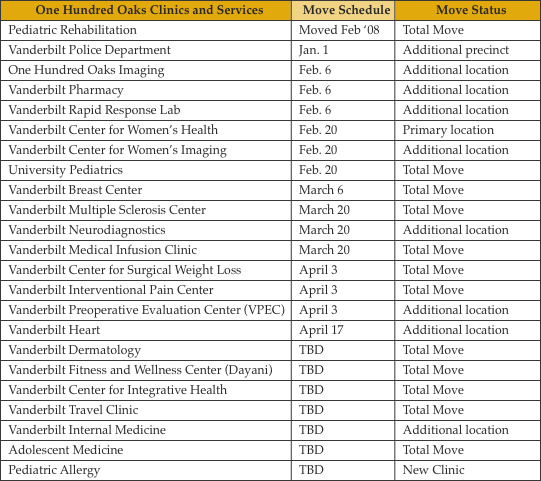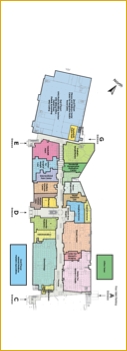They include offices that handle coding and billing—functions currently housed in offices south of Blakemore Avenue, at Crystal
Terrace and in other locations. About 400 of the VMC staff members moving to
One Hundred Oaks are finance people. Since they are coming from several
locations, they have been talking to each other and working together to “blend” their areas into a cohesive group.
The new work area at One Hundred Oaks will have 60,000 square feet and will have
a reception/waiting area so that patients who want to discuss their bills will
be able to do so.
C. Wright Pinson, M.D., associate vice chancellor for Clinical Affairs, is the
executive sponsor of this program and chairs a steering committee comprised of
key stakeholders in the overall plan for One Hundred Oaks. As a large
multi-specialty clinic, David Posch, CEO of Vanderbilt Medical Group, is
responsible for continued strategic planning. Cyril Stewart, Don Bolin, Ann
McGauran, and Karin Smith are the architects in Space and Facilities who worked
on the project from the beginning to bring together the programming, design and
construction elements. Joel Lee, Jill Austin, and Joan Cato are leading the
marketing team that met early on with focus groups to understand how this
location might be received, and how best to position this second campus for
Vanderbilt in the market. Diane Seloff joined the team as the Project Director
and has been working with the leaders of about 17 project teams to address the
construction and planning aspects of the project. The chief administrator of
Vanderbilt Health at One Hundred Oaks is Janice Smith, R.N., M.Ed., who assumes
responsibility of the second campus for operations, strategic planning and
fiscal accountability.
There is a strong desire that people who are assigned to One Hundred Oaks have a
quality workplace that is still completely integrated with the main campus.
This ranges from having ATMs at the mall to having several conference rooms
with video-conferencing ability, in order to make it easy to “meet” with colleagues. Occupational Health will provide TB skin tests, vaccinations,
lab draws for blood exposure follow-up, and blood pressure checks, among other
services.
Yes. Patients who wish to leave the clinic area and go to the food court for a
snack or a cup of coffee, can pick up a pager. When the clinic is ready, a text
message will be sent to the pager, to let the patient know to return to the
clinic entrance.
Yes. Patients will have the option of using a credit card or other magnetic
stripe card (similar to airport check-in) to access a self-check-in kiosk.
These kiosks will be located just outside each clinic front desk area, and will
identify the patient, confirm personal and insurance information, collect the
co-payment if he or she wants to pay there, and complete the check-in.
My Health at Vanderbilt is a secure online program specifically for Vanderbilt
patients. Through this online program, patients can view their personal health
information and communicate with their physicians via e-mail. Computer stations
for patient/family access to My Health at Vanderbilt will be placed throughout
the main mall waiting area, food court, and overall common area of Vanderbilt
Health at One Hundred Oaks. In some cases, by accessing My Health at Vanderbilt
prior to a clinic visit, patients can speed up the visit process.
For the first time since the beginning of mall construction in 1965, there will
be 100 oaks at One Hundred Oaks—Vanderbilt is participating with the mall’s owners in planting the oaks, along with other trees and bushes, to help the
site look better and reduce its carbon footprint.
No. Vanderbilt has signed a 12-year lease with the current developers and owners
of 100 Oaks. This lease does include a future ability to purchase property at
100 Oaks. It also means that some improvements—landscaping, exterior upgrades and leases for restaurants outside the mall—are being done by the mall owners in conjunction with Vanderbilt, but not by
Vanderbilt.
The owners of the mall are Dallas-based developers Frank Mihalopoulos and Tony
Ruggeri.
You won’t recognize it. The clinic facades, the flooring, the seating—everything about the interior has been carefully considered to provide a
pleasant environment for patients, families, staff and faculty. There have even
been windows and skylights added to bring more daylight into the concourse.
This is one attractive place to be, as you can tell from the artists’ renderings in this issue.
To better use resources, and so the same IT and phone people, for example, can
work on each move. Also, if problems come up with one move, it gives two weeks
to correct the problem before the next move.





